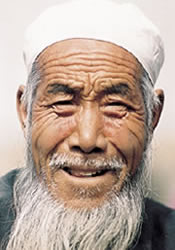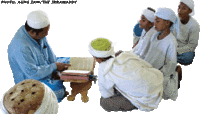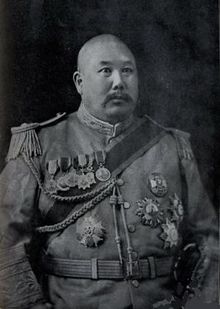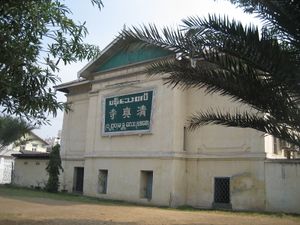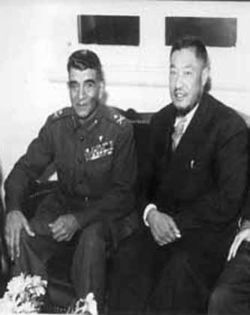پانثاي
الپانثاي Panthays يشكلون مجموعة من المسلمين الصينيين في بورما. ويشير البعض إلى الپانثاي على أنهم أقدم مجموعة من المسلمين الصينيين في بورما. إلا أنه بسبب التزاوج والاختلاط العرقي فإن الپانثاي اليوم يصعب تمييزهم اليوم كمجموعة مميزة كما كانوا من قبل.
. . . . . . . . . . . . . . . . . . . . . . . . . . . . . . . . . . . . . . . . . . . . . . . . . . . . . . . . . . . . . . . . . . . . . . . . . . . . . . . . . . . . . . . . . . . . . . . . . . . . . . . . . . . . . . . . . . . . . . . . . . . . . . . . . . . . . . . . . . . . . . . . . . . . . . . . . . . . . . . . . . . . . . . .
أصل الكلمة
پانثاي Panthay (بالبورمية: ပန်းသေးလူမျိုး; MLCTS: pan: se: lu myui: هو مصطلح يُستخدم للاشارة إلى شعب هوي المسلم في الصين الذي هاجر إلى بورما. وهم ضمن أكبر المجموعات الصينيون البورميون، ويعيشون أساساً في المناطق الشمالية لبورما (المعروفة سابقاً بإسم بورما العليا)، وخصوصاً في منطقة تانگيان-مايميو-مندلاي-تاونگيي ودويلات شان.
التاريخ
التاريخ المبكر
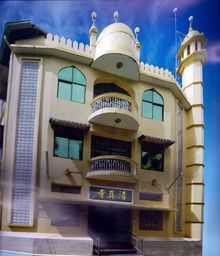
هذه الجماعة التي لا يُعرف عنها الكثير تتكلم الصينية وعرقياً ينتمون أساساً إلى صينيي الهان، وهم مسلمون سنيون يتبعون المذهب الحنفي ويشيع بينهم زواج الأقارب، ويشكلون مجتمع أقلية وثيق الترابط في أربعة بلدان – الصين، بورما، تايلند ولاوس – واليوم يمثلون كلاً من الثقافتين الإسلامية والصينية في شمال جنوب شرق آسيا.
استيطان المسلمين ليوننان
تمرد الپانثاي في يونـّان
 مقالة مفصلة: تمرد دو ونشيو
مقالة مفصلة: تمرد دو ونشيو
بين 1648 و 1878, أكثر من اثنتي عشر مليون مسلم هوي واويغور قـُتِلوا في عشر انتفاضات فاشلة ضد أسرة چينگ.[1]
الپانثاي أثناء فترة كونباونگ
الملك ميندون والپانثاي
الپانثاي الحاليون في بورما
ينتشر الپانثاي في مناطق عديدة في بورما وتتواجد مساجدهم في يانگون وتاونگيي ولاشيو وتانگيانگ وكياإنگتون وپين-او-لوين وميتكيإنا وموگوك.[2]
رجال القوافل الپانثاي
في الأزمنة قبل الاستعمار، برز الپانثاي كرجال قوافل بعيد المدى ممتازين في جنوب الصين والجزء الشمالي من جنوب شرق آسيا. وقد سيطروا بالكامل على تجارة القوافل في يوننان. ومع وصول أول العملاء والرواد المغامرين من الإمبريالية الفرنسية والبريطانية إلى أطراف يوننان، وجدوا أن شبكة القوافل في المنطقة يسيطر عليها المسلمين الصينيين.
سيطرة المسلمين الصينيين على شبكة قوافل يوننان يبدو أنها استمرت حتى في القرن العشرين. ففي منتصف القرن 19، كانت قوافل تجار يوننان غطت مساحة تمتد من الجبهات الشرقية للتبت، عبر أسام وبورما وتايلند ولاوس وتونگكين (حالياً جزء من ڤيتنام)، إلى المقاطعات الصينية الجنوبية سيچوان، گويژو وگوانگشي.
المصادر
- ^ Historical Sketch of the Hui Muslims of China
- ^ Message from Maung Ko Ghaffari, Chief Editor, Light of Islam Magazine, Burma in Feb. 2007
قراءات للاستزادة
- Anderson, John, Mandalay to Momien: A Narrative of the Two Expeditions to Western China of 1868 and 1875 (London: Macmillan, 1876).
- Ba Shin, Lt. Colonel, "Coming of Islam to Burma Down to l700 AD.," Asian History Congress (New Delhi: Azad Bhavan, 1961).
- Forbes, D.W., "The Role of Hui Muslims in the Traditional Caravan Trade between Yunnan and Thailand," Asian Merchants and Businessmen in the Indian Ocean and the China sea: 13-20 Centuries(French Journal published under the direction of Denys Lombard & Jean Aubin), (Paris: School of Higher Studies in Social Sciences, 1987).
- Kaye, J.W., Major Sladen’s Report on the Bhamo Route, (In Continuation of' Parliamentary Paper No. 251, of Session 1868-9), (London: India Office, 1871), Microfilm copy.
- Scott, J. George, GUBSS, 1, i ( Rangoon Government Printing, 1900).
- ibid GUBSS, ii, ii (Rangoon- Government Printing, 1901).
- Thaung, Dr., “Panthay Interlude in Yunnan: A Study in Vicissitudes Through the Burmese Kaleidoscope,” JBRS Fifth Anniversary Publications No. 1 (Rangoon Sarpy Beikman, 1961).
- Yule, Col. Henry & Burnell, A. C., Hobson-Jobson- A Glossary of Colloquial Anglo-Indian Words and Phrases, and of Kindred Terms, Etymological, Historical, Geographical And Discursive (Delhi-.Munshiran Manoharlal, 1968), Reprint.
- Than Tun, Dr. (Professor of History), History on Tour, 111, (In Burma) (Yangon Nantha House, August 1968).
- Parabaik dated 13 November, 1868 containing a short account of' Mah Too-tu's purchase of land and house from Khunit Ywa-sa Princess (a family parabaik of the writer).
- Interview with U Aung Myint (aged 75), a higher grade pleader, before the war, and building contractor after the war, on 11 December, 1987. Although a Burma Buddhist, U Aung Myint was very friendly with Khala Kyawt, a Burma Muslim who had lived in the Panthay Compound for many years in the pre-war days and who had in her possession a parabaik manuscript on the Tayoktan quarrel between the Chinese and the Panthays, and the circumstances leading to the granting of land by King Mindon for the residence of Panthays and the construction of the Panthay Mosque. U Aung Myint had personally read this parabaik, which, unfortunately was destroyed by fire during the war. U Aung Myint had lived close to the Panthay Compound before the war and the house in which he had lived is said to have been inside the Panthay Compound at one time.
- عبد الرحمن ظفر الدين. "100 year anniversary of Myanmar Chinese Muslim's "PANTHAY Masjid" in Mogyoke". Dr Ko Ko Gyi's Blog.
. . . . . . . . . . . . . . . . . . . . . . . . . . . . . . . . . . . . . . . . . . . . . . . . . . . . . . . . . . . . . . . . . . . . . . . . . . . . . . . . . . . . . . . . . . . . . . . . . . . . . . . . . . . . . . . . . . . . . . . . . . . . . . . . . . . . . . . . . . . . . . . . . . . . . . . . . . . . . . . . . . . . . . . .
طالع أيضاً
- الإسلام في بورما
- الإسلام في الصين
- الإسلام في الهند
- الإسلام في آسيا
- إسلام
- هنود بورميون
- روهينگيا (شعب)
- Bصينيون بورميون
- صينيون هوي
- تمرد الپانثاي
- دونگان
- مسلمون ملايو بورميون
وصلات خارجية
- Myanmar Muslim Information Centre (MMIC)-[1]
- Burmese Muslims Network- [2]
- Islamic Unity Brotherhood [3]
- Myanmar Muslim political Awareness Organization- [4]
- Panthay on line community- [5]
- Office of UN High Commissioner for Human Rights [6]
- US Department of State, International Religious Freedom Report 2005 on Burma [7]
- US Department of State, Burma, Country Reports on Human Rights Practices- 2005
- Released by the Bureau of Democracy, Human Rights, and Labor [8]
- Amnesty International’s report on Burma [9]
- UK Conservatives’ Human Rights [10]
- Priestly, Harry (2006-01). "The Outsiders". The Irrawaddy. Retrieved 2006-07-07.
{{cite news}}: Check date values in:|date=(help) - Butkaew, Samart (2005-02). "Burmese Indians: The Forgotten Lives" (PDF). Burma Issues. Retrieved 2006-07-07.
{{cite news}}: Check date values in:|date=(help) - The Persecution of Muslims in Burma, by Karen Human Rights Group

